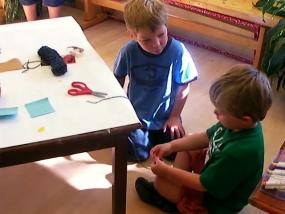A String Too Short

What makes a child persist in his attempts to make something work? Are repeated attempts at the same strategy a mark of high-level thinking or indicative of the absence of creative problem solving? If a strategy does not work, does the child become frustrated or change the goal? Let’s look at this clip with these questions in mind.
Henry (in green) wants to make the string taunt, from table-top to floor, so his imaginary animals can safely slide down into the water. At 00:26, he successfully anchors the string to the floor with a piece of tape, and the string is now taunt. In an action meant to help Henry, Wesley accidentally separates the string from its mooring. Wesley explains, “I was going to press it down,” meaning that the separation was not at all his intent. Henry wants Wesley to understand his perspective, so he says, with some despair in his voice, “I did some really hard work.” One can see that these two boys are friends. Watch how the cross currents throughout the clip are tolerated with kindness, flexibility, and clear language.
Returning to the initial question, what makes this problem hard to solve? First, the string is almost, but not quite, too short to give Henry an extra inch to bend and tape the string flat to the floor. The "almost" teases him to persist. Second, to create more length to the floor he would have to un-tape the end on the table, and that is counter-intuitive. Henry worked hard to tape that end of the string, and furthermore, he managed to tape the string to the floor and make it taunt once before. Third, Henry focuses on positioning the string on the floor before he applies the tape. That means the hand holding the string down is in the way of the tape. It would be much easier to first put a piece of tape on the end of the string held in the air and then move the string with tape to the floor as a unit. But children typically have trouble engaging in such detour moves that are not part of the final goal. Since the string must end up anchored to the floor, children naturally think to anchor the string to the floor with their fingers, but then the fingers are in the way and are not “available” to press the tape.
Regarding the parallel element of collaboration, note that the boys move back and forth in allowing help, rejecting help, and even changing goals to maximize the quality of their play. There is a break in the video around 4:40, but after this break we see that now there are two strings, the original short one and a much longer one, neither taped. Henry explains that the bad guys use the short string to escape and no doubt bump at the bottom. The good guys use the longer string that has a run-out at the bottom. This bending escape path yields a soft landing for the good guys. In this manner Henry and Wesley have rewritten the script to accommodate a string-too-short. Indeed, now the shortness becomes an important prop for the drama of their story instead of a problem to solve. Such is the power of play.
Keywords: Fives, Children-Teacher, Glue, Tape, Collaboration
Length of video: 5 minutes 10 seconds
